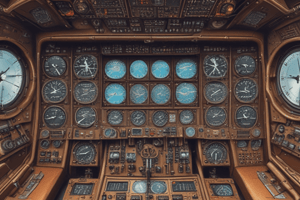Podcast
Questions and Answers
What is the primary function of the turn coordinator?
What is the primary function of the turn coordinator?
- To monitor the rate of turn and the quality of the turn (correct)
- To display a picture of the aircraft in relation to the horizon
- To mitigate compass errors
- To provide the aircraft's heading relative to magnetic north
What is the primary cause of deviation in a magnetic compass?
What is the primary cause of deviation in a magnetic compass?
- Magnetic fields within the aircraft distorting the compass reading (correct)
- The difference between true north and magnetic north
- The aircraft's turn or acceleration
- The Earth's magnetic field lines being inclined downwards towards the poles
What is the name of the instrument that provides an aircraft's heading relative to magnetic north?
What is the name of the instrument that provides an aircraft's heading relative to magnetic north?
- Heading indicator (correct)
- Turn coordinator
- Attitude indicator
- Directional gyro
What is the purpose of periodically adjusting the heading indicator?
What is the purpose of periodically adjusting the heading indicator?
What is the name of the process used to mitigate compass errors?
What is the name of the process used to mitigate compass errors?
What type of error affects the compass as the aircraft changes latitude or when it accelerates or decelerates?
What type of error affects the compass as the aircraft changes latitude or when it accelerates or decelerates?
What is the primary function of the attitude indicator?
What is the primary function of the attitude indicator?
What is the primary advantage of the heading indicator over the magnetic compass?
What is the primary advantage of the heading indicator over the magnetic compass?
What type of power is used to power the turn coordinator?
What type of power is used to power the turn coordinator?
What is the primary reason why the heading indicator must be periodically adjusted?
What is the primary reason why the heading indicator must be periodically adjusted?
The turn coordinator is powered pneumatically.
The turn coordinator is powered pneumatically.
The heading indicator is affected by the aircraft's acceleration.
The heading indicator is affected by the aircraft's acceleration.
The attitude indicator displays a picture of the aircraft's heading relative to magnetic north.
The attitude indicator displays a picture of the aircraft's heading relative to magnetic north.
Variation is caused by magnetic fields within the aircraft.
Variation is caused by magnetic fields within the aircraft.
The gyro in the attitude indicator is mounted at an angle.
The gyro in the attitude indicator is mounted at an angle.
Dip is an error caused by the Earth's magnetic field lines being parallel to the horizon.
Dip is an error caused by the Earth's magnetic field lines being parallel to the horizon.
The turn coordinator senses both pitch and yaw.
The turn coordinator senses both pitch and yaw.
The heading indicator is used to provide a picture of the aircraft in relation to the horizon.
The heading indicator is used to provide a picture of the aircraft in relation to the horizon.
The attitude indicator is powered pneumatically or electrically.
The attitude indicator is powered pneumatically or electrically.
The process of 'swinging the compass' is used to mitigate variation errors.
The process of 'swinging the compass' is used to mitigate variation errors.
What is the key difference in the way a gyroscopic instrument senses roll and yaw compared to a non-gyroscopic instrument?
What is the key difference in the way a gyroscopic instrument senses roll and yaw compared to a non-gyroscopic instrument?
How does the attitude indicator provide a constant horizon reference, and why is this critical for instrument flight?
How does the attitude indicator provide a constant horizon reference, and why is this critical for instrument flight?
What are the three primary sources of compass errors, and how do they affect the magnetic compass reading?
What are the three primary sources of compass errors, and how do they affect the magnetic compass reading?
What is the primary advantage of using a gyroscopic instrument like the heading indicator over a magnetic compass?
What is the primary advantage of using a gyroscopic instrument like the heading indicator over a magnetic compass?
What is the purpose of the turn coordinator, and how does it aid the pilot in maintaining coordinated turns?
What is the purpose of the turn coordinator, and how does it aid the pilot in maintaining coordinated turns?
What is the effect of precession on the heading indicator, and how is it accounted for?
What is the effect of precession on the heading indicator, and how is it accounted for?
How does the turn coordinator sense both roll and yaw, and what is the advantage of this?
How does the turn coordinator sense both roll and yaw, and what is the advantage of this?
What is the role of the gyro in the attitude indicator, and how does it provide a picture of the aircraft's orientation?
What is the role of the gyro in the attitude indicator, and how does it provide a picture of the aircraft's orientation?
How does the heading indicator differ from the magnetic compass in terms of its response to the aircraft's turn or acceleration?
How does the heading indicator differ from the magnetic compass in terms of its response to the aircraft's turn or acceleration?
What is the significance of the Earth's magnetic field lines being inclined downwards towards the poles, and how does this affect the magnetic compass?
What is the significance of the Earth's magnetic field lines being inclined downwards towards the poles, and how does this affect the magnetic compass?
Flashcards are hidden until you start studying
Study Notes
Gyroscopic Instruments
- Gyroscopes form the crux of gyroscopic instruments, with properties of rigidity in space and precession, allowing them to remain stable in their plane of rotation, resisting external forces.
- The mechanical anatomy of gyroscopes is vital, with a rotor spun at high speed, facilitating their rigidity in space.
Turn Coordinator
- The turn coordinator indicates the rate of turn and confirms the aircraft's roll information, providing immediate feedback for smooth and balanced maneuvers.
- It consists of a gyro mounted at an angle, enabling it to sense both roll and yaw.
Heading Indicator (Directional Gyro)
- The heading indicator displays the aircraft's current heading relative to magnetic north, unaffected by the aircraft's turn or acceleration.
- It is powered either pneumatically or electrically and must be periodically adjusted to account for precession, aligning it with the magnetic compass.
Attitude Indicator (Artificial Horizon)
- The attitude indicator displays a picture of the aircraft in relation to the horizon, telling the pilot whether the wings are level and if the aircraft is climbing or descending.
- The gyro in the attitude indicator is mounted in a horizontal plane, relying on rigidity in space to provide a constant horizon reference.
Compass Errors
- Magnetic variation is the angular difference between true north and magnetic north, affecting navigation and requiring correction.
- Magnetic deviation is an error specific to the aircraft, caused by local magnetic fields created by its components and electrical systems.
- Magnetic dip is an error caused by the Earth's magnetic field lines being inclined downwards towards the poles, affecting the compass as the aircraft changes latitude or accelerates/decelerates.
Correcting Compass Errors
- "Swinging the compass" is a process used to measure and mitigate magnetic deviation, involving a methodical dance of aligning the aircraft on known headings and noting disparities on a deviation card.
- Correcting for compass errors is crucial for precise navigation and safety.
Gyroscopic Instruments
- Gyroscopes form the crux of gyroscopic instruments, with properties of rigidity in space and precession, allowing them to remain stable in their plane of rotation, resisting external forces.
- The mechanical anatomy of gyroscopes is vital, with a rotor spun at high speed, facilitating their rigidity in space.
Turn Coordinator
- The turn coordinator indicates the rate of turn and confirms the aircraft's roll information, providing immediate feedback for smooth and balanced maneuvers.
- It consists of a gyro mounted at an angle, enabling it to sense both roll and yaw.
Heading Indicator (Directional Gyro)
- The heading indicator displays the aircraft's current heading relative to magnetic north, unaffected by the aircraft's turn or acceleration.
- It is powered either pneumatically or electrically and must be periodically adjusted to account for precession, aligning it with the magnetic compass.
Attitude Indicator (Artificial Horizon)
- The attitude indicator displays a picture of the aircraft in relation to the horizon, telling the pilot whether the wings are level and if the aircraft is climbing or descending.
- The gyro in the attitude indicator is mounted in a horizontal plane, relying on rigidity in space to provide a constant horizon reference.
Compass Errors
- Magnetic variation is the angular difference between true north and magnetic north, affecting navigation and requiring correction.
- Magnetic deviation is an error specific to the aircraft, caused by local magnetic fields created by its components and electrical systems.
- Magnetic dip is an error caused by the Earth's magnetic field lines being inclined downwards towards the poles, affecting the compass as the aircraft changes latitude or accelerates/decelerates.
Correcting Compass Errors
- "Swinging the compass" is a process used to measure and mitigate magnetic deviation, involving a methodical dance of aligning the aircraft on known headings and noting disparities on a deviation card.
- Correcting for compass errors is crucial for precise navigation and safety.
Gyroscopic Instruments
- Gyroscopes form the crux of gyroscopic instruments, with properties of rigidity in space and precession, allowing them to remain stable in their plane of rotation, resisting external forces.
- The mechanical anatomy of gyroscopes is vital, with a rotor spun at high speed, facilitating their rigidity in space.
Turn Coordinator
- The turn coordinator indicates the rate of turn and confirms the aircraft's roll information, providing immediate feedback for smooth and balanced maneuvers.
- It consists of a gyro mounted at an angle, enabling it to sense both roll and yaw.
Heading Indicator (Directional Gyro)
- The heading indicator displays the aircraft's current heading relative to magnetic north, unaffected by the aircraft's turn or acceleration.
- It is powered either pneumatically or electrically and must be periodically adjusted to account for precession, aligning it with the magnetic compass.
Attitude Indicator (Artificial Horizon)
- The attitude indicator displays a picture of the aircraft in relation to the horizon, telling the pilot whether the wings are level and if the aircraft is climbing or descending.
- The gyro in the attitude indicator is mounted in a horizontal plane, relying on rigidity in space to provide a constant horizon reference.
Compass Errors
- Magnetic variation is the angular difference between true north and magnetic north, affecting navigation and requiring correction.
- Magnetic deviation is an error specific to the aircraft, caused by local magnetic fields created by its components and electrical systems.
- Magnetic dip is an error caused by the Earth's magnetic field lines being inclined downwards towards the poles, affecting the compass as the aircraft changes latitude or accelerates/decelerates.
Correcting Compass Errors
- "Swinging the compass" is a process used to measure and mitigate magnetic deviation, involving a methodical dance of aligning the aircraft on known headings and noting disparities on a deviation card.
- Correcting for compass errors is crucial for precise navigation and safety.
Studying That Suits You
Use AI to generate personalized quizzes and flashcards to suit your learning preferences.




